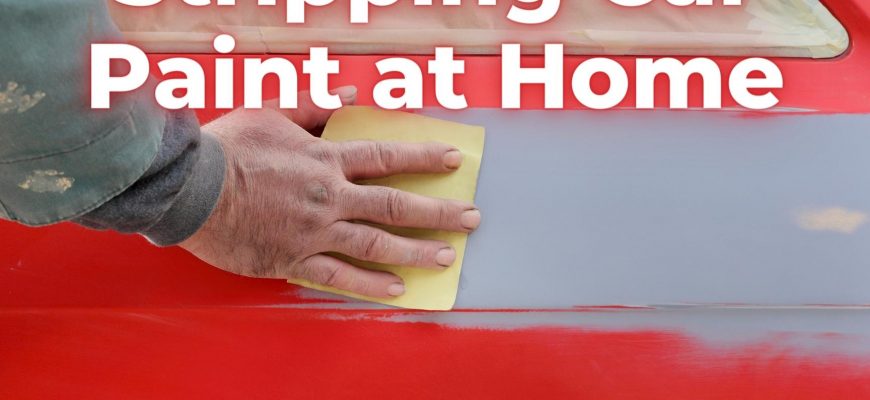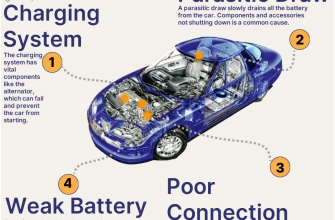Whether you’ve had a minor accident‚ experienced paint overspray‚ or simply want to restore your vehicle’s original color‚ removing paint from your car can be a daunting task․ However‚ with the right methods and materials‚ you can do it effectively and safely․ Below are some of the most effective techniques for removing paint from your car․
- 1․ Chemical Paint Strippers
- 2․ Sanding
- 3․ Heat Gun
- 4․ Abrasive Materials
- 5․ Professional Help
- 6․ Surface Restoration
- 7․ Regular Maintenance
- 8․ Professional Detailing
- 9․ Knowing When to Seek Help
- 10․ The Importance of Patience and Precision
- 11․ Environmental Considerations
- 12․ DIY vs․ Professional Services: Making the Right Choice
- 13․ Safety First
- 14․ Final Touches: Sealing the Deal
- 15․ Celebrating Your Success
1․ Chemical Paint Strippers
Chemical paint strippers are one of the most effective ways to remove paint from your car․ These products work by breaking down the bond between the paint and the surface of your vehicle; Here’s how to use them:
- Choose the Right Product: Look for a paint stripper that is safe for use on automotive surfaces․ Water-based options are usually less harmful and easier to clean up․
- Prep the Area: Work in a well-ventilated space‚ and wear protective gloves and goggles to shield yourself from harmful chemicals․
- Apply the Stripper: Follow the manufacturer’s instructions for application․ Typically‚ you’ll apply a thick layer of the stripper using a brush․
- Wait and Scrape: Allow the stripper to sit for the recommended time‚ then use a plastic scraper to gently remove the paint․
2․ Sanding
Sanding is a tried-and-true method for removing paint‚ especially if you’re dealing with several layers or stubborn spots․ Here’s how to do it effectively:
- Choose Sandpaper: Start with a coarser grit (around 80-120) for initial removal‚ then switch to a finer grit (220-400) for smoothing the surface․
- Wet Sanding: For better results and to minimize dust‚ consider wet sanding․ Use water to keep the sandpaper moist and lubricated․
- Sand with Care: Apply even pressure and keep the sandpaper moving to avoid damaging the underlying surface․ Always sand in the direction of the grain to reduce scratches․
3․ Heat Gun
A heat gun can be an effective tool for softening paint‚ making it easier to scrape off․ Here’s how to use one:
- Preparation: Ensure the area is clear and safe․ Wear heat-resistant gloves to protect your hands․
- Heat the Paint: Hold the heat gun a few inches away from the surface and gradually heat the paint until it starts to bubble․
- Scrape Off the Paint: Use a plastic scraper to gently peel away the softened paint․ Be cautious not to overheat and damage the underlying material․
4․ Abrasive Materials
For light paint overspray or minor blemishes‚ abrasive materials like clay bars or polishing compounds can be useful․ Here’s how:
- Clay Bar: Use a clay bar with a lubricant to gently rub over the painted area․ This method is ideal for removing contaminants without damaging the clear coat․
- Polishing Compound: Apply a polishing compound with a microfiber cloth or a buffer to help lift light paint marks․ This method works best for fresh paint overspray․
5․ Professional Help
If you’re feeling overwhelmed or the paint damage is extensive‚ it might be best to consult a professional․ Auto body shops have specialized tools and chemicals that can safely and effectively remove paint without harming your vehicle’s finish․
Removing paint from your car doesn’t have to be a headache․ With these effective methods‚ you can restore your vehicle’s look while maintaining its integrity․ Remember to always prioritize safety and follow instructions carefully․ Whether you opt for chemical strippers‚ sanding‚ a heat gun‚ or seek professional assistance‚ your car can shine again in no time!
Once you’ve successfully removed paint from your car‚ the next steps are crucial in ensuring your vehicle looks as good as new․ It’s not just about removing the unwanted paint; it’s also about restoring the finish‚ protecting the surface‚ and maintaining the overall aesthetic of your automobile․
6․ Surface Restoration
After the paint is removed‚ you may notice that the surface of your car isn’t as smooth or shiny as it once was․ Here’s how to restore that luster:
- Polishing: Using a quality automotive polish can help eliminate scratches and restore shine․ Apply the polish with a microfiber cloth or a dual-action polisher for an even finish․
- Waxing: Once polished‚ applying a coat of wax will provide a protective layer against environmental damage․ Waxing not only enhances the shine but also helps shield your car’s paint from UV rays‚ dirt‚ and moisture․
- Clear Coat Application: For those who want extra protection‚ applying a clear coat can seal the surface and give it a glossy finish․ This is particularly useful if you’ve sanded down the surface․
7․ Regular Maintenance
Maintaining your car’s paint job is essential to prevent future damage․ Here are some maintenance tips to keep your vehicle looking its best:
- Regular Washing: Clean your car regularly to remove dirt‚ grime‚ and contaminants․ Use pH-balanced car shampoo to avoid stripping away protective wax layers․
- Avoid Harsh Chemicals: Steer clear of abrasive cleaners and harsh chemicals that can damage the paint․ Always use products specifically designed for automotive finishes․
- Park Smart: Whenever possible‚ park in shaded areas or use a car cover to protect against UV rays‚ which can fade paint over time․
8․ Professional Detailing
If you find yourself overwhelmed by the maintenance process or if your car has gone through significant wear and tear‚ consider investing in professional detailing․ A detailing service can provide a comprehensive clean‚ polish‚ and wax that rejuvenates your car’s appearance․ Additionally‚ they often include services like interior cleaning and engine bay detailing‚ ensuring your vehicle looks pristine inside and out․
9․ Knowing When to Seek Help
While DIY methods can be effective‚ there are times when it’s best to consult a professional․ If you’re dealing with:
- Extensive Damage: Large areas of paint that need removal or damage that has reached the underlying metal․
- Complex Finishes: Specialized paint jobs‚ such as metallic or custom finishes that require expert handling․
- Uncertainty: If you’re unsure about the best method to use‚ reaching out to a professional ensures that the job is done right․
Removing paint from your car can be an involved process‚ but with the right techniques and care‚ you can restore your vehicle to its former glory․ Remember‚ the key to a successful paint removal is not just in the methods you choose but also in the follow-up care you provide․ By investing time in maintenance and restoration‚ you can protect your car’s appearance and value for years to come․ So roll up your sleeves‚ put on those gloves‚ and get ready to bring back the shine!
10․ The Importance of Patience and Precision
When it comes to removing paint from your car‚ patience is a virtue․ Rushing through the process can lead to mistakes that may cost you more time and money in the long run․ Take your time to carefully assess the areas that need attention‚ and choose the method that best suits your specific situation․ Precision in your technique will ensure a clean finish and reduce the risk of damage to the underlying surface․
11․ Environmental Considerations
As you embark on your paint removal journey‚ it’s crucial to consider the environmental impact of the products you use․ Many paint strippers and solvents contain harmful chemicals that can be detrimental to both your health and the planet․ Look for eco-friendly alternatives that are biodegradable and less toxic․ Always use these products in well-ventilated areas‚ and dispose of any waste responsibly․
12․ DIY vs․ Professional Services: Making the Right Choice
Choosing between a DIY approach and hiring a professional can be a tough decision․ If you’re comfortable with tools and have the time‚ DIY methods can save you money․ However‚ if the paint removal task seems overwhelming or you have no experience‚ enlisting the help of professionals can ensure a job well done․ They have the expertise and equipment needed to tackle even the most challenging paint removal situations effectively․
13․ Safety First
Safety should always be your top priority․ When working with chemicals‚ wear appropriate protective gear such as gloves‚ goggles‚ and a mask to prevent inhalation of fumes․ Ensure you have adequate ventilation in your workspace‚ and keep flammable materials away from heat sources․ Following safety protocols not only protects you but also ensures a smooth and effective paint removal process․
14․ Final Touches: Sealing the Deal
Once the paint has been successfully removed‚ consider applying a sealant to protect the freshly exposed surface․ A quality sealant can provide an additional layer of defense against moisture‚ dirt‚ and future paint issues․ This step is particularly important if you’ve removed a significant amount of paint or have exposed bare metal․
15․ Celebrating Your Success
After all the hard work‚ take a moment to appreciate your efforts․ Step back and admire your handiwork; you’ve transformed your car! Whether you’ve restored its original shine or prepared it for a new paint job‚ your diligence has paid off․ Snap a few pictures to document the before-and-after transformation—it’s a great way to celebrate your success and share your achievement with fellow car enthusiasts․
Removing paint from your car may seem daunting‚ but with the right knowledge and techniques‚ it can be a rewarding experience․ From choosing the right method to ensuring safety and environmental responsibility‚ each step is crucial in achieving the best results․ Whether you opt for DIY methods or professional assistance‚ what matters most is that you take the time to do it right․ So gear up‚ get started‚ and let your car shine like never before!










Fantastic article! The safety tips for using chemical strippers were very reassuring. I feel more confident now.
This guide has all the information you need to safely remove paint from your car. I wish I had found it sooner!
The section on using a heat gun was particularly informative. I never thought about that method before. Great job!
I appreciate how thorough this article is. The advice about wet sanding was a game changer for me. Very practical!
This article is a lifesaver! I had no idea how to tackle paint removal, but the tips on chemical strippers were super helpful. Thanks!
I loved the step-by-step guide on sanding. It made the process so much less intimidating. Highly recommend this read!
Great tips and easy to follow instructions! I successfully removed old paint from my car thanks to this article!